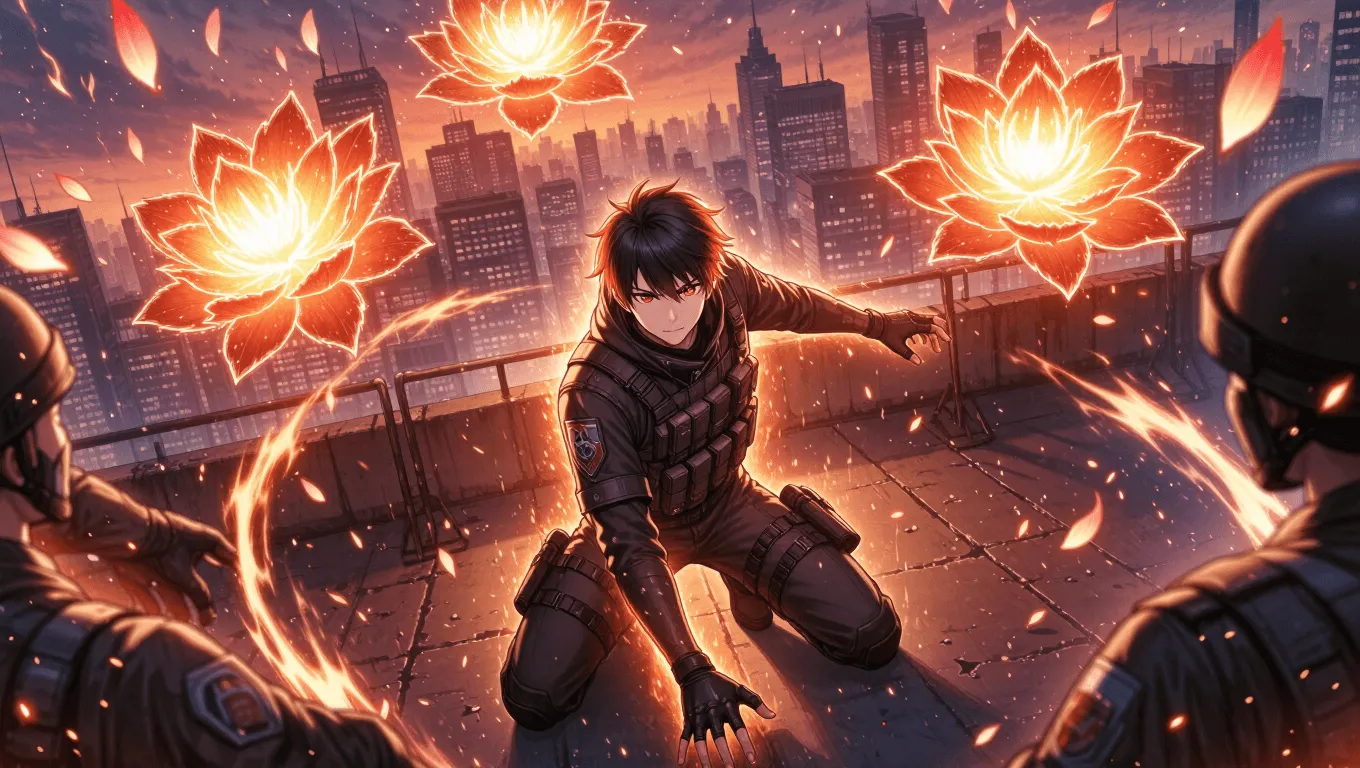Inferno Lotus

Inferno Lotus Video Demo 🎬
Table of Contents
- Inferno Lotus Video Demo 🎬
- What Is Inferno Lotus
- Core Abilities of Inferno Lotus
- Application / Tactical Advantages in Combat
- Level: Level 1 🏙️, Level 2 🌇, Level 3 🌃
- Limitations of Using the Inferno Lotus
- Weakness Against What Other Superpowers
- Synergistic Power Combos
- Known Users
- Frequently Embedded Keywords and Concepts (for clarity)
- Practical Training Tips
- Ethical and Civilian Uses
- Glossary Snapshot
Inferno Lotus is a rare fire-based superpower where flames manifest as blooming lotus shapes that can be shaped, grown, and detonated with precision. As a subtype of pyrokinesis and flame manipulation, Inferno Lotus lets a user weave thermal energy into petals, vines, and seeds of fire. The result is a style that mixes beauty and battlefield control—a living garden of heat that can defend, trap, and overwhelm. This guide breaks down the core abilities, tactical advantages, power levels, limits, counters, combos, and notable users. For more powers and definitions, explore the living library on the site’s superpower wiki, or try the random superpower generator for inspiration.
What Is Inferno Lotus
Inferno Lotus refers to the controlled generation of lotus-like fire constructs that grow, fold, and release heat in timed stages. Unlike standard fire control, the user plants “seeds” of flame that sprout into lotus blooms, each capable of illumination, shielding, or explosive thermal discharge. The power fuses artistic expression with combat practicality: every bloom is a node the user can command, redirect, or sacrifice to create bursts, screens, or scorching traps.
In short, Inferno Lotus is pyrokinesis evolved into a horticultural pattern. A skilled wielder can scatter small embers that later flower into radiant petals, coil them into chains or whips, shape them into protective rings, and synchronize them like a choreography of heat.
Core Abilities of Inferno Lotus
Floral Flame Constructs
The user creates lotus-shaped fire constructs—buds, petals, and full blossoms. Petals function as modular blades of heat, while buds store potential energy. Full blooms act as multi-purpose platforms: they can hover, stick to surfaces, or orbit the user as a fiery crown. The construct geometry gives fine-grained control compared to blunt fireballs.
Thermal Blooming and Staged Ignition
Each bloom follows stages—seed → bud → blossom → cinder. The wielder can accelerate or delay stages, causing a bloom to emit warmth for comfort, flash-cook an area with a heat wave, or burst into a directional flare. Staged ignition is the signature mechanic that separates Inferno Lotus from conventional combustion control.
Petal Barrage and Petal Recall
Petals can detach and fly as a volley—thin, cutting slivers of high-temperature plasma that cauterize on contact. With petal recall, petals boomerang back to reform the bloom or dock into a shield, conserving energy and minimizing waste.
Lotus Shields and Rings
By interlocking petals, the user forms circular shields—either stationary domes or rotating rings that deflect projectiles by superheating the air to create thermal updrafts. Strong users layer rings for area denial and crowd control.
Lotus Tethers and Vines
Fire can take the shape of flexible vines that wrap enemies or snag debris. These tethers sear lightly at first, tightening with each command. They double as mobility tools—swing lines, heat-formed ladders, or anchors to vault across gaps.
Scorching Aura and Heat Field
At close range, the user projects a regulated aura: enough to melt restraints, sterilize wounds, thaw ice, or force melee attackers to back off. The aura can be shaped into bands that protect allies by disrupting incoming cold or dampening toxins through high heat neutralization (with careful control).
Ember Seeds and Delayed Traps
The user plants ember seeds—barely visible motes that adhere to surfaces. On command they blossom, creating a surprise flare, a wall of petals, or a soft lantern for signaling. This delayed planting mechanic is central to ambushes and retreats.
Thermal Senses (Advanced)
Some users develop a thermal “bloom-sense,” reading air currents and temperature gradients radiating from their own constructs. This grants rough environmental awareness—detecting hidden movement by the way heat diffuses around obstacles.
Application / Tactical Advantages in Combat
Area Denial and Zoning
By planting ember seeds along choke points, the user shapes the battlefield into concentric circles of risk. A single command can blossom multiple nodes into overlapping petals that block sight lines, ignite ground hazards, or create radiant barriers. Against swarm tactics, a rotating lotus ring shreds momentum and pushes enemies into safer lanes for allies.
Burst Damage with Surgical Control
Petal barrages offer rifle-like precision without collateral firestorms. The user can snipe with a narrow petal spear, or fan petals to clip multiple targets. When detonation is needed, staged blossoms deliver sweeping heat waves tuned to non-lethal crowd dispersal or decisive shock.
Defensive Flexibility
Lotus shields can be translucent, letting allies see through shimmering air. Interlocked petals absorb blunt force by flexing and venting heat. If a shield cracks, the user can turn the fragments into counterattacking shards, converting defense to offense seamlessly.
Mobility and Terrain Shaping
Tethers become climbing lines and swing points. Temporary flaming lilies can float over water or hazardous ground, acting as stepping-stones that briefly solidify with magnetic confinement of plasma. In urban settings, heat vents from blooms weaken brittle materials to open paths or seal doors.
Morale and Visibility
The visual spectacle—glowing lotus gardens in midair—can intimidate foes and rally allies. Controlled light helps in low-visibility operations, signaling formations or marking safe corridors.
Level: Level 1 🏙️, Level 2 🌇, Level 3 🌃
Level 1 🏙️ — Ember Gardener

At the entry level, the user manifests palm-sized blooms with moderate heat. They can:
-
Create 1–3 stable lotus constructs for up to a minute each
-
Perform short-range petal barrages (non-lethal scorch)
-
Form a basic lotus ring shield for brief blocks
-
Plant ember seeds with a 10–15 second delay before blooming
-
Maintain a mild scorching aura for deterrence
Focus areas: safety, control, and spacing. Typical use cases include signaling, cooking in the field, warming teammates, and simple barricades.
Level 2 🌇 — Bloomwright

Control improves and the garden grows. They can:
-
Maintain 5–9 blooms simultaneously with independent timers
-
Fire precision petal lances and curve shots via microdraft control
-
Interlock multi-ring shields for layered defense
-
Use lotus tethers for athletic movement across rooftops
-
Lay complex trap patterns (staggered or chain blooms)
At this tier, the user orchestrates bloom choreography—seeding flanks, funneling enemies, and syncing detonations. Rescue operations benefit from thermal cutting and heat sterilization.
Level 3 🌃 — Lotus Sovereign

At mastery, the battlefield becomes a living conservatory of flame. They can:
-
Sustain 12+ blooms with dynamic scaling from candle-soft to furnace-hot
-
Generate floating platforms and rotating petal storms with precise no-collateral arcs
-
Shape macro-scale heat fields to redirect smoke, fog, or tear gas away from allies
-
Split-second reconfigure: turn shields into barrages, vines into bands, and seeds into beacons
-
Read heat currents as a radar-like field for situational awareness
This level demands disciplined restraint to prevent structural damage and heat fatigue among teammates. The user’s presence can dominate open ground and tight corridors alike.
Limitations of Using the Inferno Lotus
-
Fuel and Stamina: While the power conjures flame, the user’s body pays an energy cost. Extended maintenance of many blooms drains calories, hydration, and focus. Overuse leads to tremors or delayed reaction times.
-
Atmospheric Dependence: High humidity, heavy rain, vacuum exposure, or oxygen-depleted zones degrade bloom stability. Petals sputter and tethers become unreliable.
-
Collateral Heat: Even with controlled edges, radiant heat can warp materials, trigger sprinklers, or consume oxygen in confined spaces. Evacuation and ventilation planning are essential.
-
Thermal Feedback: Reflective barriers, cold shocks, or sudden drafts can bounce or quench petals unpredictably. The user must constantly adapt to microclimate shifts.
-
Line-of-Sight and Anchor Points: Complex structures (tight ducts, submerged tunnels) limit the user’s ability to “plant” ember seeds and shape lotus geometry.
-
Emotional Regulation: Anxiety spikes or rage can accelerate blooming stages unintentionally, forcing premature detonations or losing fine control.
Weakness Against What Other Superpowers
-
Cryokinesis / Cold Domination: Rapid heat extraction makes petals brittle and collapses lotus rings. Ice casters can flash-freeze tethers mid-swing.
-
Hydrokinesis / Storm Calling: Pressure waves and water curtains strip petals from their stems, extinguish seeds, and saturate air with steam that clouds visibility.
-
Vacuum Manipulation / Air Deprivation: Removing oxygen or thinning air snuffs blooms before they form.
-
Light-Bending / Photokinesis (Defensive): Mirrors and refraction screens redirect radiant output, limiting the aura’s effectiveness for intimidation or targeting.
-
Sound Manipulation / Shockwaves: Sonic bursts break petal cohesion, scattering the bloom and disrupting staged ignition timing.
-
Gravikinesis: Sudden gravity shifts distort petal arcs and collapse floating platforms.
Synergistic Power Combos
-
Aerokinesis: Wind sculpting sharpens petal trajectories, carries ember seeds into tight spaces, and feeds oxygen to sustain shapes at lower energy cost.
-
Geomancy / Earth Shields: Stone bulwarks absorb collateral heat while lotus blooms project over the top, creating layered strongholds and safe firing lanes.
-
Illusion Casting: Glamours overlay the real bloom placements, baiting opponents into traps while masking ember seed positions.
-
Kinetic Barriers: Pairing translucent force fields with lotus rings forms hybrid shields: heat softens incoming threats, kinetic layers disperse force.
-
Healing / Biokinesis: Controlled warmth aids circulation and sterilization during field triage, while a medic teammate prevents heat exhaustion.
-
Technomancy: Smart filaments and heat sensors embedded in armor ping when ember seeds are in range, enabling synchronized blooms with tactical HUD cues.
Known Users
-
Lian Yan (Lotus Warden): A disciplined urban defender who mapped city ventilation systems to route heat harmlessly above rooftops.
-
Asha Karun: A firefighter-turned-hero who refined non-lethal petal shields that protect evacuees from smoke and debris.
-
Arman Sol: A travelling martial artist who uses lotus tethers to fight across vertical terrain, turning alleys into aerial arenas.
-
Comparable Comic Archetype: For readers seeking a familiar benchmark in mainstream comics, consider the precision heat shaping and spectacle of characters like the Human Torch (Johnny Storm). While not a one-to-one match, that link helps visualize heat control at scale and flight-adjacent maneuvering.
Frequently Embedded Keywords and Concepts (for clarity)
Inferno Lotus, pyrokinesis, flame manipulation, thermal energy control, fire constructs, petal barrage, lotus shield, ember seeds, staged ignition, heat field, scorching aura, lotus tethers, area denial, delayed traps, combustion control, fire bloom, lotus storm, floral flame, martial synergy, battlefield control.
Practical Training Tips
Safety and Calibration
Start with hand-width blooms over nonflammable surfaces. Practice staged ignition on a metronome count to build reliable timing. Keep extinguishers and cooling gels nearby. Schedule cooldown phases to prevent heat stress and dehydration.
Pattern Memory and Choreography
Assign numbers to bloom positions and run set plays—“1-3-5 blossom, 2-4 shield”—to reduce cognitive load. Record thermal maps after drills to review where heat pooled and where petals drifted.
Urban vs. Wilderness
In cities, watch for sprinkler systems, gas lines, and reflective glass. In forests or grassland, use minimal-output petals and elevated floating lilies to avoid ground ignition. If a backburn is necessary for wildfire control, coordinate with hydrokinesis allies for perimeter steam curtains.
Team Communication
Use light pulses from small blooms as silent signals: one pulse for advance, two for rotate, three for retreat. This keeps radios clear in high-noise encounters and reduces detection.
Ethical and Civilian Uses
Inferno Lotus isn’t only for combat. Its precise, tunable heat has broad civic value:
-
Emergency Response: Generate safe corridors through smoke by shaping updrafts; sterilize medical tools on-scene; gently thaw frozen valves during winter crises.
-
Construction and Repair: Heat-treat metals, remove damaged paint layers, or accelerate curing compounds in controlled zones.
-
Agriculture and Ecology: Controlled burns to prevent wildfires, with lotus rings acting as living firebreaks; night illumination for search-and-rescue without loud generators.
-
Art and Culture: Choreographed flame gardens for festivals, with safety-first practice blooms and remote ignition cutoffs.
Glossary Snapshot
-
Bloom: A lotus-shaped fire construct at its peak stage; versatile platform for attack or defense.
-
Petal: A detachable blade of heated plasma used for precision strikes or to interlock into shields.
-
Ember Seed: A tiny pre-bloom mote that adheres to surfaces and later sprouts on command.
-
Staged Ignition: Timed development of a bloom’s heat output across defined phases.
-
Lotus Ring: Interlocked petals forming a spinning or static defensive barrier.
-
Lotus Tether: Flexible vine-like flame for grappling, tripping, or mobility.
For more entries like Inferno Lotus and to compare across elemental and tactical archetypes, browse the superpower wiki. If you’re scouting ideas for a character build or story, spin the random superpower generator and see what blooms next.
